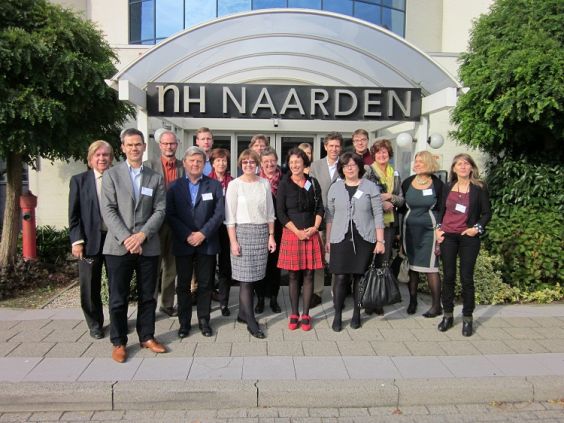European Reference Networks (ERN) – recommendations and criteria in the Neuromuscular field
- Number 200
- Date 18 October 2013
Location: Naarden
co-sponsored by the Dutch ZonMw Association. ![]()
The 200th ENMC workshop took place in Naarden on 18th-20th October with 18 attendees from 9 countries.
The group came together to discuss ways to apply for funding to the European Union and establish a new type of network across Europe that focuses solely on neuromuscular conditions. The initiative would be part of a larger activity called European Reference Networks (ERN). ERNs are being established in order to improve health care across Europe for patients with rare diseases and other conditions where expertise is rare. The aim is to give Centres of Expertise (CoE) in different countries incentives to work together to allow expertise and knowledge to travel rather than patients themselves. At the same time the network will permit for patients to travel to cross-border CoE when necessary. For CoE to be part of a network they have to fulfill a set of criteria that involve the expertise to diagnose, follow a multi-disciplinary approach to provide high quality care, make a contribution to research and organize teaching and training opportunities for professionals. The funding and resources that CoE will need to fulfill these criteria will have to be provided nationally by the different European member states.
The final way that ERNs will work is not yet fully decided, but the legal framework setting them up is likely to be in place from 2014 with the first networks coming into existence in 2015. The group agreed that it was likely that having a neuromuscular ERN could offer new opportunities for patients with neuromuscular conditions across Europe to benefit from better and more uniform care. In order to not reinvent the wheel and make use of already existing infrastructure they reviewed different organizations and initiatives which have already in place to try and improve collaboration and cross talk between different centres. The work of the ENMC in uniting patient organisations and to act as a think tank and incubator for new ideas was highlighted. The work of previous networks and projects such as TREAT-NMD and CARE NMD was also discussed, and many of the resources developed through these projects such as the patient registries, work on care standards and outcome measures and the Care and Trial Site Registry could be highly relevant to the establishment of an ERN.
There are many very sophisticated systems in place in different countries of how clinicians and health professionals are organized that allow them to provide high quality neuromuscular care and these were discussed. The mechanisms for networks, recognition of centres and national registries which are already in place offers good examples of how this might translate to an ERN. While many examples of highly organized care do exist it is also clear that there are other areas where this is lacking and addressing this inequality of access to good care and diagnosis could be a major positive output of a neuromuscular ERN. The current role of scientific societies in training and education and how they would fit in an ERN was also discussed.
A report outlining the current status of neuromuscular networking in the different European countries and our understanding of the opportunities offered by an application to develop neuromuscular ERN is published in Neuromuscular Disorders (pdf).

ENMC
Lt. generaal van Heutszlaan 6
3743 JN BAARN
The Netherlands
+ 31- 35-5480481
enmc@enmc.org
